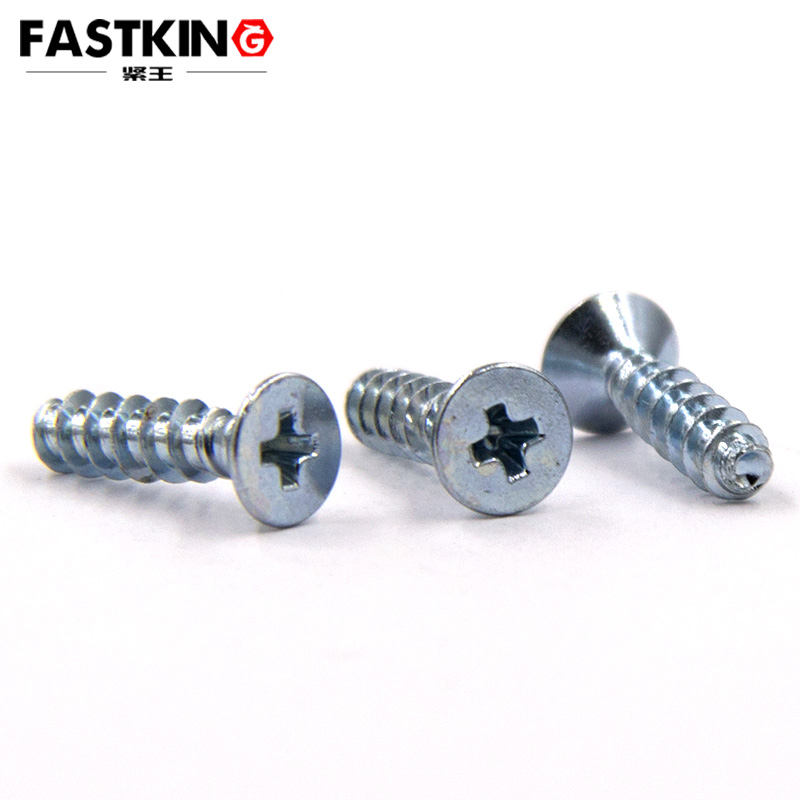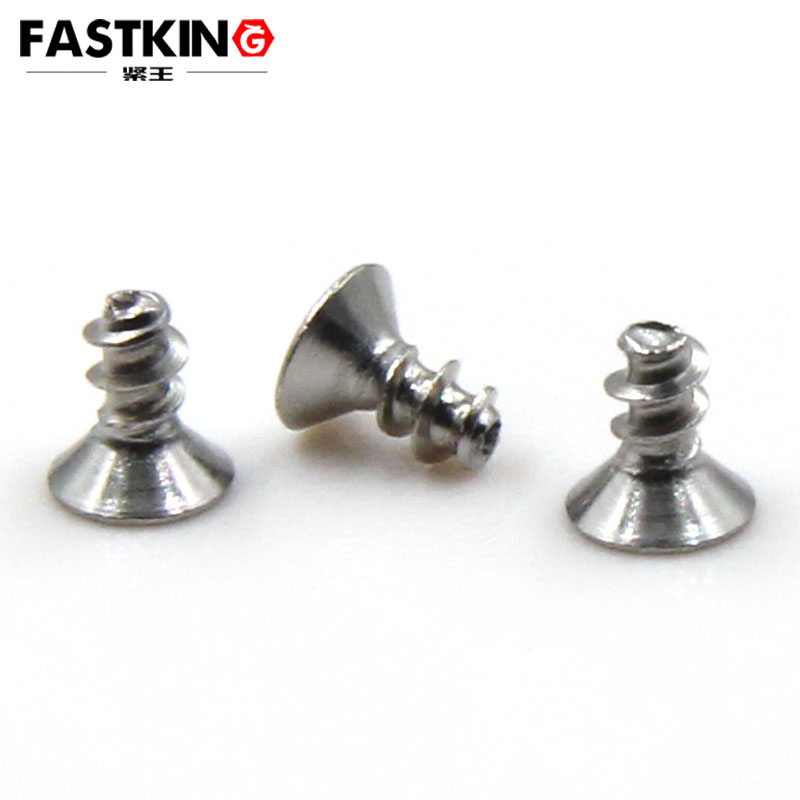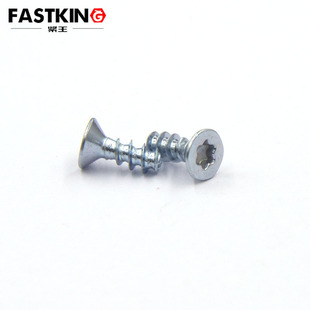- Torx screw,torx machine screw,torx self tapping screw
- sales@jlfastener.com
Self-tapping screws of plastic teeth in the countersunk head
Torx tapping screw
Self-tapping screws of plastic teeth in the countersunk head
- Description:In the electronics, home appliance, and automotive interior sectors—where the proportion of plastic parts is increasingly rising—traditional self-tapping screws often cause plastic cracking and thread
From the perspective of core structure, the "plastic-thread" design is what distinguishes it from ordinary self-tapping screws. Traditional self-tapping screws mostly have sharp or coarse threads; when driven into plastic parts, they tend to cut excessive material, leading to expansion of threaded holes and thread stripping. This issue is particularly prominent in soft plastics such as PP and ABS, significantly shortening the fastening service life. In contrast, plastic-thread self-tapping screws adopt a special thread profile with fine threads and rounded crests, with a thread pitch usually controlled between 0.5-1mm (e.g., M3 specification with a 0.5mm pitch). During insertion, the rounded crests and thread flanks gently compress the plastic, causing uniform plastic deformation to form a tightly fitting thread pair, rather than forcibly cutting the material. Test data shows that in 5mm-thick ABS plastic parts, the thread stripping rate of plastic-thread screws is reduced by more than 70% compared to ordinary coarse-thread self-tapping screws. Moreover, after 3 repeated disassembly cycles, they can still maintain over 80% of the fastening force, greatly improving the reusability of plastic components.
The "countersunk head" design perfectly meets the aesthetic and safety requirements of plastic parts. Plastic parts are often used as product casings or exposed components (e.g., home appliance panels, automotive center console trim). The protruding heads of traditional screws are prone to scratching users or affecting appearance. The head of the countersunk-head internal hexagon plastic-thread self-tapping screw is in a 120° conical shape; when paired with the pre-drilled counterbore in the plastic part, it can be completely embedded after installation, leaving the surface flat and free of protrusions. For example, in the assembly of plastic casings for smart robotic vacuum cleaners, the countersunk head design ensures a smooth casing surface, preventing it from catching on carpets during cleaning. In the connection of children's toy casings, the flat surface eliminates the risk of scratches during play, complying with toy safety standards.
The "internal hexagon socket" structure further enhances the reliability and safety of plastic part assembly. Fastening plastic parts requires precise torque control (usually only 1-3N·m). Traditional slotted or Phillips-head screws are prone to "slippage" (tool slipping out of the slot) due to improper torque control, damaging the screw head or the plastic counterbore. The internal hexagon socket forms a tight engagement with a dedicated tool through its hexagonal curved notch, achieving a torque transmission efficiency of up to 98%. This allows precise control of the fastening force, avoiding crushing the plastic counterbore due to excessive force. Meanwhile, the internal hexagon socket requires a dedicated wrench for operation, preventing unauthorized disassembly by non-professionals. In smart home appliances (e.g., robotic vacuum cleaners, coffee machines), this prevents users from disassembling the device on their own and damaging internal plastic structures, ensuring normal equipment operation.

In terms of performance adaptability, countersunk-head internal hexagon plastic-thread self-tapping screws have undergone multiple optimizations for plastic characteristics. In terms of materials, mainstream products use 1018 low-carbon steel (with galvanized or nickel-plated finishes) or 304 stainless steel. The hardness of low-carbon steel is controlled between HV250-300 to avoid cracking the plastic due to excessive hardness; 304 stainless steel is suitable for humid environments (e.g., bathroom appliances), preventing coating peeling from contaminating plastic parts. Additionally, some high-end products are coated with a nylon adhesive layer on the thread surface. After insertion, the nylon adhesive forms additional friction with the plastic threaded hole, improving the anti-loosening effect by more than 50% compared to ordinary screws. This is particularly suitable for long-term vibration scenarios such as automotive interiors (e.g., plastic brackets for instrument panels), preventing abnormal noise caused by screw loosening.
From the perspective of application scenarios, this screw has become a "standard component" for fastening plastic parts in multiple fields. In the electronics industry, it is used to fix plastic casings and internal PCB boards of routers and set-top boxes; the plastic thread prevents damage to the plastic support pillars around the PCB board, while the countersunk head design ensures a flat casing surface. In the home appliance industry, the connection of plastic inner tubs to brackets in washing machines and the fixing of plastic air deflectors in air conditioners both rely on its gentle fastening method to prevent plastic parts from cracking during long-term use. In the automotive industry, for fixing plastic battery pack guards and plastic buckles on interior door panels of new energy vehicles, plastic-thread screws can adapt to plastic parts of different thicknesses without the need to customize multiple specifications, reducing procurement costs for automakers.
However, to fully utilize its performance, selection and installation must follow the "plastic adaptation principle". During selection, the appropriate specification should be chosen based on the hardness of the plastic material: for ultra-soft plastics such as PP and PE, small specifications (e.g., M2×4) are recommended to avoid material deformation caused by excessively large threads; for hard plastics such as PC and POM, M3-M4 specifications can be used to ensure sufficient fastening force. During installation, a torque wrench must be used, and the torque should be set based on the plastic thickness (e.g., for M3 screws driven into 3mm-thick ABS plastic, the recommended torque is 0.8-1.2N·m) to avoid over-tightening due to manual feel. Additionally, the depth of the plastic counterbore must match the height of the screw head precisely; usually, the counterbore depth should be 0.2-0.3mm greater than the head height to prevent the head from being exposed or the plastic from thinning and breaking due to an overly deep counterbore.

The emergence of countersunk-head internal hexagon plastic-thread self-tapping screws marks the evolution of fasteners from "general-purpose" to "material-specific". Designed specifically to address the weaknesses of plastic materials, it not only solves the fastening pain points of traditional screws but also balances aesthetics and safety, becoming a "must-have component" amid the growing proportion of plastic parts in products. With the application of new materials such as bioplastics and modified plastics, plastic-thread self-tapping screws will further optimize their thread profiles and materials in the future (e.g., using more gentle titanium alloy materials), providing more precise fastening solutions for new plastic components and driving plastic products toward being lighter, thinner, and more durable.


